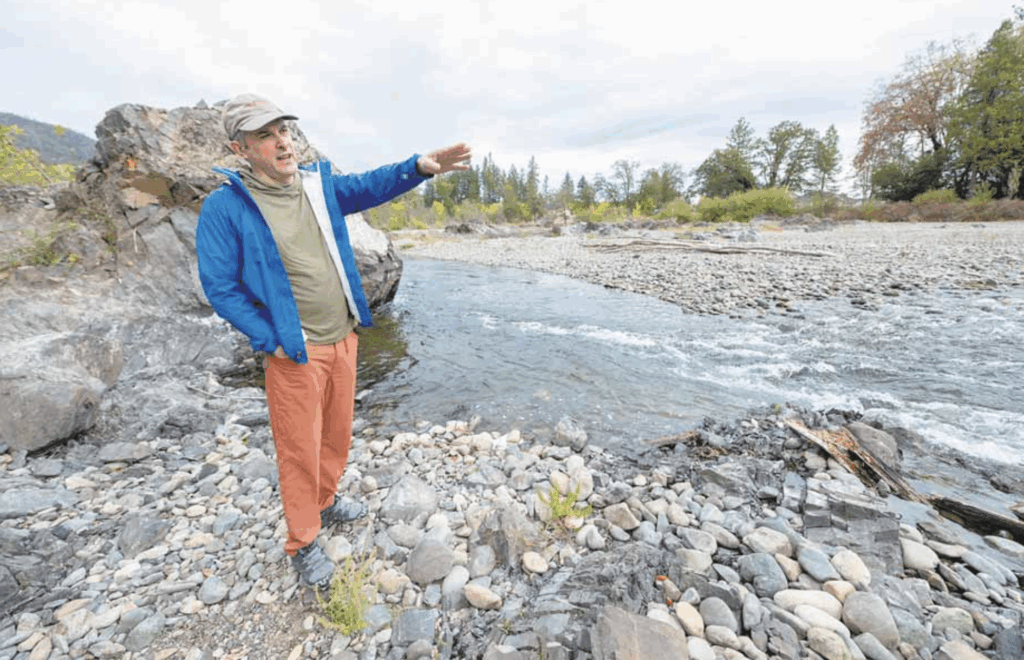By Chrissy Ewald | Oct. 12, 2025 | Grants Pass Daily Courier
One year after a concrete irrigation dam that spanned the Illinois River was demolished and removed, it’s hard to tell the dam was ever there.
It was too early in the season on Thursday to see fall chinook salmon, but small juvenile fish were visible in some of the stiller pools below boulders at the former Pomeroy Dam site.
Where the 10-foot tall dam once arced 270 feet across the Illinois now lies an island of cobble, and where the reservoir pool used to be is now a mix of cobble, exposed bedrock, and scour pools.
“You can see it’s got a whole bunch of complexity now,” Jim McCarthy of WaterWatch of Oregon said on Thursday, gesturing at the riverbank in the former reservoir. “You’ve got the cobble beach still, but now you’ve got all these nooks and crannies and this side channel. This is all habitat and rearing for small fish — same thing downstream.”
WaterWatch, a nonprofit organization with offices in Portland and Ashland, spearheaded the dam removal as part of an ongoing project to free the Rogue River and its tributaries of human-made barriers to native, migratory fish.
The dam, which dates back to the 1940s and was built for irrigation, was listed for years as a priority barrier to fish passage by the Oregon Department of Fish and Wildlife (ODFW).
ODFW found the dam was a barrier to fall chinook, coho, winter steelhead, cutthroat trout, suckers and Pacific lamprey, a species of jawless fish.
A lawsuit filed on behalf of WaterWatch in 2022 against a local ranch that owned the dam led to an agreement to remove it.
At a cost of $3.7 million, the dam was removed last year and replaced with irrigation pumps and a solar array to power them.
Money came from a mix of sources, including the federal government, state government, and conservation group grants.
Fish had been able to get over the dam, which did not have a fish ladder, but ODFW found that during some parts of the year, the dam was a barrier to fish.
“Fish were above the dam, fish were below the dam, it’s just that they had a hard time crossing,” McCarthy said. “Plus, you know, they have a limited time window and they have limited energy to get to where they need to go, so it was removed so they can get to the spawning grounds.”
More than 100 miles of upstream fish habitat were made easier to access by the dam’s removal, McCarthy said.
“It’s a good feeling,” he said. “You never get tired of seeing a restored river.”
Because it was only a partial barrier, the dam removal hasn’t been as dramatic as some of the high-profile removals across the West over the past several decades. There was no “first fish” moment for salmon returning to long-restricted territory. But McCarthy said biologists with ODFW have been monitoring fish spawning in the former reservoir and in the nearby creeks. How far fish can get up tributaries and how soon is weather-dependent, he said, but dam removal should mean fish can move farther and earlier.
It can take time to measure fish response. In publications about other dam removal projects, ODFW said it takes 25 or more years to tease out the environmental variation that affects the abundance of salmon and steelhead.
Part of the dam removal project included replacing two road culverts that were also barriers to fish passage on nearby creeks.
Another creek that was formerly diverted into an irrigation canal for the ranch was reconnected to the river, so fish are able to access it again.
Pomeroy is far from the first dam WaterWatch has worked to remove in the Rogue Basin over the past several decades.
In June 2024, the 128-year-old Williams-Whalen Dam, which also lacked a fish ladder, was removed from Evans Creek north of the town of Rogue River.
More high-profile dam removals in the area included the Gold Hill Diversion Dam in 2008, Savage Rapids Dam in 2009, and Gold Ray Dam in 2010, all on the mainstem of the Rogue River.
The dam removals have not been met with universal acclaim. A group of neighbors living in a nearby subdivision rallied against the Pomeroy Dam removal before it happened, and state Sen. Noah Robinson, R-Cave Junction, then a candidate, sent out a flyer opposing it.
The efforts have paid off for fish passage, at least in the view of the state. Earlier this year, ODFW released an updated list of priority fish passage barriers — no barriers in the Rogue Basin are in the four highest-priority categories.
This article originally appeared in the Oct. 12, 2025, issue of the Grants Pass Daily Courier. Banner photo by the Daily Courier’s Julie Anderson.

